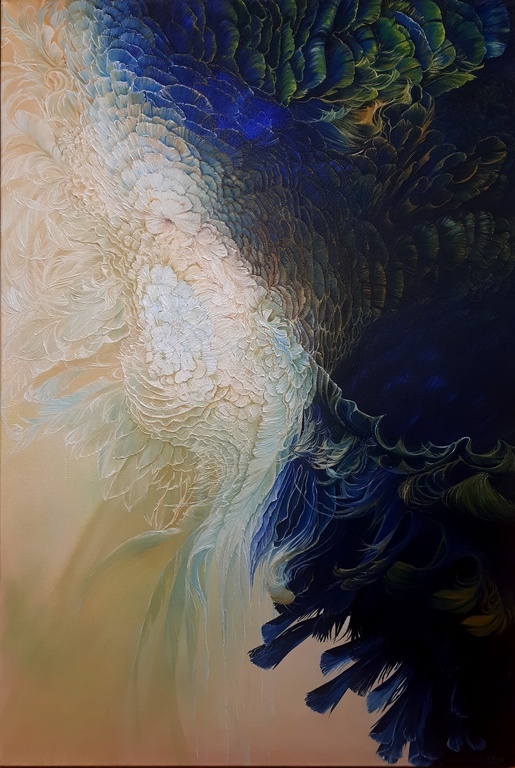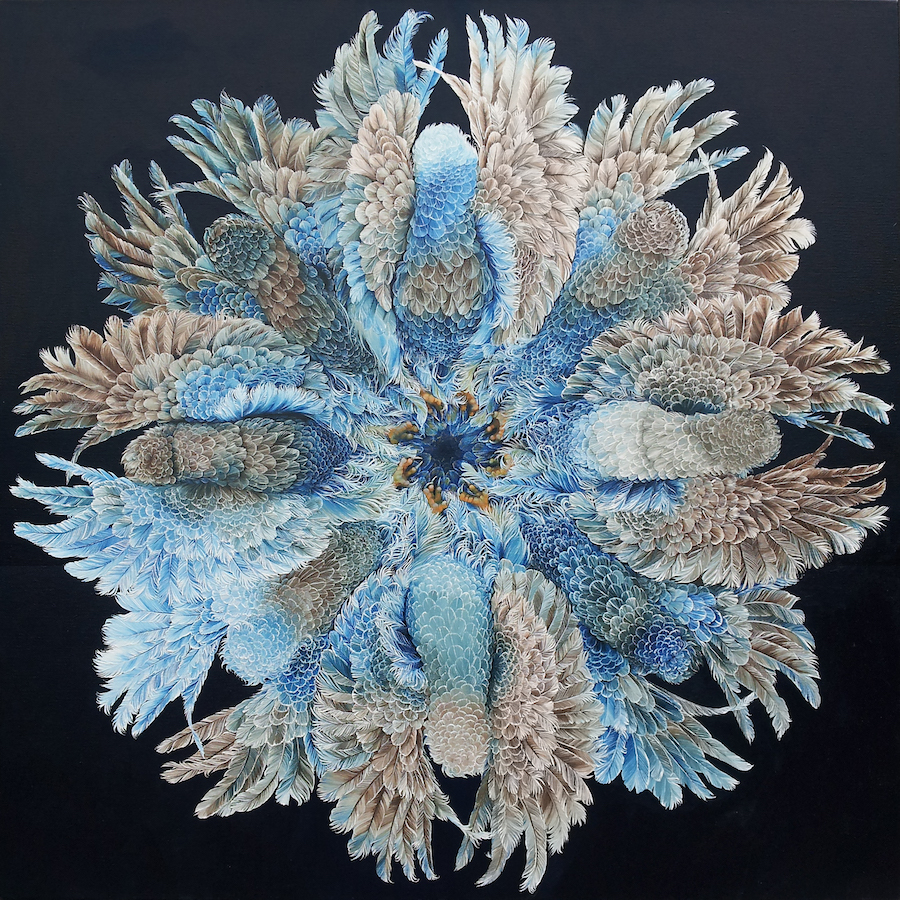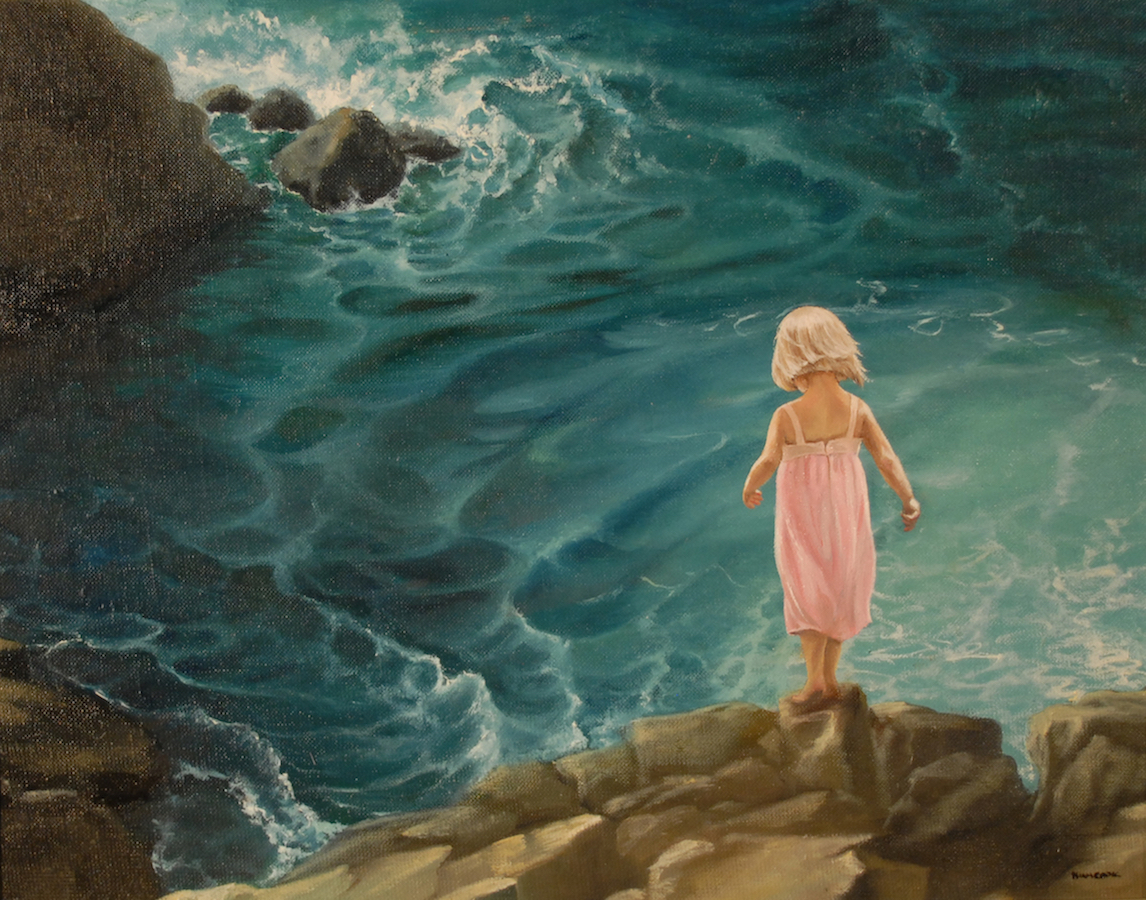The Explanatory Gap
As the laws and patterns of nature reveal themselves through scientific discovery and our intellectual comprehension expands, we pat ourselves on the back. We are comfortable (and comforted) with the idea that our world is becoming more comprehendible (if not the implications of our mis-use of it).
But what we are less willing to acknowledge, is how correspondingly our native (intuitive, assumptive) ‘understanding’ grows and adjusts, profoundly influencing our feelings and beliefs about the universe we inhabit. We tend to think of our mystical relationship with the world as belonging in a pre-science time. But what I observe is more aligned with a contemporary updating (in difference to overwriting) of myth.
My work explores these concepts from both my personal personal experience, but also thrnough observing the broader conversation in society through media and eavesdropping. Still my filter, but a broader than entirely personal context.
Nature flows with matter effected energies of differing frequencies and polarities, which never-the-less form recognisable patterns and shapes. The familiarity I experience with these forms feels more than simply having seen them in macro and microscopic viewfinders. They feel ‘right’ – they feel like home.
Why feathers? Because I needed a bridge – and over my years of painting I have developed a visual language through feathers that seems to work. I love the fact that feathers have been so long in existence (from the time of dinosaurs) and that they already play such a significant role in folk law, mythology, poetry and symbolism.
My hope is that, through observing the works you will feel the spark of recognition – the spark of ‘us’ and ‘home’ and how incredible and beautiful ‘we’ ‘I’ ‘it’ ‘us’ ‘our’ ‘whole’ are.
Blind. Disinclined. Intertwined. Redefined.
My ‘Blind’ series is about how little we know of the universe, the world, others’ lives. We feel, experience, intellectualise, conceptualise, empathise, extrapolate and guess.
In this instance feathers represent the weight of thoughts as we navigate attractive and repelling forces.
People who believe their limited experience to be definitive are stupid beyond my comprehension.
“Blind certainty, a close-mindedness that amounts to an imprisonment so total that the prisoner doesn’t even know he’s locked up.” David Foster
OPENING – 11th March – 7th April 2017 – Little River Gallery
The narrative/impetus for this series of works is deeply personal. Broadly, it is about a cycle of profound hurt to intense release.
Opening: to force an opening (to breach) through to Opening: to release and truly open up.
The process is integral and is one of concentrated, open-minded patience, requiring me to stay alert to paint (viscosity, brush loading, etc) and compositional characteristics in much the same way as fully abstract works demand. These cannot be rushed, nor the movements/marks allowed to become repetitively mechanical. To do so would be to undermine the intention of the work.
The works initially appear highly decorative and orderly – feathers mean birds. But on closer inspection, these are not any birds you’d recognise. Their physiology is different (wrong? altered?). The colours and intensity are emotive, the mark-making intense. These irregularities draw you in, encourage observation and contemplation. But ultimately you are released to once again to simply enjoy the decorative qualities of these jewels.
That they are designed to be hung at any angle, allows the image to be changed/refreshed at will. This allows the viewer input into the relationship each work has with its surroundings. The round paintings are very effective in groupings, allowing differences between the works to intensify each other.
Frame Of Mind – Little River Gallery 3rd – 28th September 2016
For this exhibition, I am exploring issues of societal bias through a personal lens.
The effect of proselytized overly fixed viewpoints on political, religious, racial, gender and environmental issues is alarming. When this alarm is combined with the information bias that occurs in this curated information age, our dual desires to belong and control are kicked into overdrive.
I am not immune to this, but am also shocked at the lack of empathy or comprehension of ‘other’ that some people exhibit. This body of work is my way of trying to understand.
Though many (including myself) try to be independent, compassionate, open-minded and critical in our thinking, we cannot avoid being influenced. Not only by our own experience and state of mind, but also by broader cultural, societal, and scientific relevancies. And this is always changing.
Art a fantastic way of exploring issues because it combines both intellectual and intuitive practices.
The frame is overt, pedantic. As in a museum display, it provides a curated context, which is only ever part of the story.
The content captures personal situations and impressions – things I have felt, seen and imagined.
Whilst painting, I have been deliberately mindful of my thought process. I asked myself;
What is the true impetus for this work?
What narrative is cycling/growing in my mind?
How is this effecting my choices?
At what point/s does my ‘frame of mind’ become ‘confirmation bias’?
To what degree is bias necessary?
When does it become a liability?
I didn’t discover any big answers, just personal ones – but every bit helps.
Some clues are reflected in the work titles, much more in the works themselves as physical manifestations of my frame of mind.
Most importantly, I am inviting the viewer to reflect upon their own frame of mind or state of bias whilst investigating mine.
Mythological Determinism
“Of all the distinctions between man and animal, the characteristic gift which makes us human is the power to work with symbolic images: the gift of imagination. The power that man has over nature and himself lies in his command of imaginary experience. Almost everything we do that is worth doing is done first in the mind’s eye.” Jacob Bronowski (condensed from a speech to the American Academy of Arts and Letters).
Myth is how we understand and communicate aspects of our world that we do not fully comprehend – it is traditionally our way of trying to wrest control from perceived chaos & to pass lessons throughout generations.
Determinism is the doctrine that all events, including human choices and decisions, have sufficient causes, and that they exemplify natural laws.
Mythological Determinism is the idea that mythological beliefs (no-matter how out of context) influence both our perception of the present and consequently how we shape the future. Modern physics and observation of global and local events show how the human race has a powerful influence over natural laws.
Each work is a present day fable that explores how we choose personal mythologies from an eclectic pick ‘n mix, in which depth of understanding is lost to our overriding sense of entitlement and habits of convenience. This context influences our perception of the present and consequently determines our future. There is a lot of modern mythology around current issues, but I think that by observing the effects of older myths we are slightly less defensive and therefore more able to view and think with an open mind.
These works represent, initially, a conversation I have with myself (around the above concept). As I research, paint and think, my view fills out, becoming more nuanced, layered and complex. When seen and interpreted by others, the conversation continues to broaden and/or aspects are clarified.
Sometimes I like to work in a more rawly emotional, less mannered and – on first glance – illustrative way, but am loathed to lose the accessibility and invitation to conversation that working in this more broadly accessible way encourages.
A Certainty of Chaos – collective nouns
A pantheon of Gods, a culture of bacteria, a charm of hummingbirds, a superfluity of nuns, an implausibility of gnus, a plethora of ideas.
And, if I have learned anything in the past year, a cluster of chaotic events is a certainty.
In science, chaos theory is about finding the underlying order in apparently random data. In life, it is a lesson in control, or lack thereof.
It is no surprise that chaos theory’s first practitioner was a meteorologist – Edward Lorenz. We in Christchurch expend a lot of energy predicting and analysing the spiralling unpredictability’s of weather and this ethos has readily transferred to earthquakes – to no effect, but it makes us feel better.
The fractal structures that IBM employee, Benoit Mandelbrot, found in cotton price fluctuations moved chaos theory into the real world.
Everything – from blood vessels to plate tectonics- and probably even our DNA, follow the same apparently chaotic spiral paths that reflect the rhythm of life that drives all things. They (we) are self-similar – chaotic fractals.
This body of work explores my mind-set over the past year. Through earthquakes and the resultant architectural, domestic and personal upheavals, the realisation of the depth of my attachments to the physical world and the imagined solidity these attachments afforded me. I have come to realise I am little more than a curious infant in my comprehension of the world, its workings and my part in it.
The black frames are an expression of desire for control – to capture and confine ideas.
The ideas are sections of spiralling combinations of emotional (disordered?) and intellectual (ordered?) responses to specific situations and ideas. They are an attempt to gain understanding.
Adams 1-3 “The nature of peoples is first crude, then severe, then benign, then delicate, finally dissolute” (Giambattista Vico 1668-1744). Vico’s philosophy ran counter to the intellectual trends of the time. Rather than based on indisputable truths, Vico saw reason as not some impartial (objective) tool, but rather developed out of the irrational foundations of human culture. Adams 1-3 were inspired by observing my son. They are not portraits, but rather that I saw broader human nature reflected through close and compassionate observation of him.
Mythological Attachments
Mythology is the inevitable outcome of real events being witnessed and filtered through minds over time. Filtered through finite knowledge, feelings, impressions and intuitions, myths are distilled beyond fiction to something hinting at universal experience.
From the signing of the Treaty of Waitangi and the assumption of British sovereignty in the 1840’s, settlers migrated to New Zealand. These people came to be known as Pākehā.
The 1970s’ Māori cultural renaissance caused many Pākehā to feel that they lacked a culture of their own, and so they began to explore issues of Pākehā identity and culture.
Pākehā contemporary culture is an amalgam of cultural practices, tensions, and accommodations.
Being both lovers and consumers of the land creates particular conflict.
These works explore connection to land, identity, and spirituality from Pākehā perspectives. The series is representative of both personal, and discovered myths about being a New Zealander of European origin.
The narrative approach is inspired by individual life stories and myths. Symbolism is used to link the individual stories to group issues of physical connection, secularism and spirituality, nationalism, and history/ancestry.
Intimate Distance – Portraiture
Painting a portrait is a very intimate act, and creating a portrait of someone dear to me adds to that intimacy. With deeper familiarity I am clearer in what I want to say.
Whilst I do like to convey a certain amount of visual realism – a ‘likeness’, I also want to say, or put on record, something about who he or she is. I want most of all, to record fantastic qualities that are often overlooked. I try to capture a vivid sense of a real person’s presence – to cut through superficial pretence and show their deeper selves. This is largely intuitive.
Distance enables me to intellectualise this information and make technical decisions about how it might be best conveyed.
I greatly admire the old masters, who with the discovery of oil painting during the sixteenth century in Europe, developed and refined techniques that remain unsurpassed to this day.
I use both old and new techniques in my work. Where the media is representative of old, my compositions are based on current knowledge and aesthetics. I love the tension between current content and old classical technique.
Other Exhibitions:
Solo exhibition, Under The Red Verandah, 2007
Solo exhibition, Cultured Gallery, 2007
Solo exhibition, COCA (Center of Contemporary Arts), 2008
Solo exhibition, Little River Gallery, 2010
Solo exhibition, Little River Gallery, 2011
Solo exhibition, Little River Gallery, 2012
Joint exhibition, Kereru Gallery, 2012
Solo exhibition, Little River Gallery, 2015









